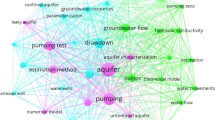Abstract
Strategically applied geo-environmental clean-up methods require a better groundwater flow and transport model. Hydraulic conductivity of the subsurface is one of great sources of uncertainty of this model. In order to search hydraulic conductivities, the simultaneous search-based pilot point method (SSBM) was developed to reduce computational procedure of pilot point method and increase characterization accuracy using a global optimization tool (genetic algorithm). SSBM searches pilot point locations and hydraulic conductivities at selected pilot points simultaneously. In the four different scenarios, the comparison between random pilot point locations and SSBM showed that SSBM produced less than two orders magnitude differences in terms of average of minimum fitness for thirty trials (e.g. 4.05E−02 for scenario 2). With respect to average minimum fitness and average hydraulic conductivity difference, SSBM was comparable to D-optimality based pilot point method (DBM). SSBM produced lower average minimum fitness values and similar average hydraulic conductivity difference but it had more variance. Through these results, SSBM showed the potential to replace the DBM through reduced computational procedures in sensitivity calculation with consideration of variance minimization.








Similar content being viewed by others
References
Alcolea A, Carrera J, Medina A (2006) Pilot points method incorporating prior information for solving the groundwater flow inverse problem. Adv Water Resour 29(11):1678–1689
Bard Y (1974) Nonlinear parameter estimation. Academic Press, New York
Cardini F, De Sanctis J, Bertoli I, Zio E (2012) Upscaling of a dual-permeability Monte Carlo simulation model for contaminant transport in fractured networks by genetic algorithm parameter identification. Stoch Environ Res Risk Assess. doi:10.1007/s00477-012-0595-8
Certes C, de Marsily G (1991) Application of the pilot point method to the identification of aquifer transmissivities. Adv Water Resour 14(5):284–300
Chavent G (1979) Identification of distributed parameter system: about the output least square method, its implementation, and identifiability. In: Isermann R (ed) Identification and system parameter estimation, vol 1. Pergamon, New York, pp 85–97
Chavent G, Bissell R (1998) Indicator for the refinement of parameterization, inverse problems in engineering mechanics. In: Tauaka M, Dalikravich GS (eds) International symposium on inverse problems in engineering mechanics. Elsevier, Amsterdam
De Marsily G, Lavedan G, Boucher M, Fasanino G (1984) Interpretation of interference tests in a well field using geostatistical techniques to fit the permeability distribution in a reservoir model. In: Geostatistics for natural resources characterization, pt. 2. D. Reidel, Boston
Doherty J (2003) Ground water model calibration using pilot points and regularization. Ground Water 41(i2):170–178
Emsellem Y, de Marsily G (1971) An automated solution from the inverse problem. Water Resour Res 7(5):1264–1283
Fasanino G, Molinard J-E, de Marsily G, Pelce V (1986) Inverse modeling in gas resvoir. Soc Petrol Eng J SPE 15592 15:18
Hernandez AF, Neuman SP, Guadagnini A, Carrera J (2003) Conditioning mean steady state flow on hydraulic head and conductivity through geostatistical inversion. Stoch Environ Res Risk Assess 17:329–338
Holland JH (1975) Adaptation in natural and artificial systems. University of Michigan Press, Ann Arbor
Jung Y, Ranjithan RS, Mahinthakumar G (2011) Subsurface characterization using D-optimality based pilot point method. J Hydroinf 13(4):775–793
Kowalsky MB, Finsterle S, Williams KH, Murray C, Commer M, Newcomer D, Englert A, Steefel CI, Hubbard SS (2012) On parameterization of the inverse problem for estimating aquifer properties using tracer data. Water Resour Res 48(W06535):1–25
LaVenue M, de Marsily G (2001) Three-dimensional interference test interpretation in a fractured aquifer using the pilot point inverse method. Water Resour Res 37(11):2659–2675
LaVenue AM, Pickens JF (1992) Application of a coupled adjoint sensitivity and kriging approach to calibrate a groundwater flow model. Water Resour Res 28(6):1543–1569
LaVenue AM, RamaRao BS, de Marsily G, Marietta MG (1995) Pilot point methodology for automated calibration of an ensemble of conditionally simulated transmissivity fields application. Water Resour Res 31(3):495–516
McLaughlin D, Townley LR (1996) A reassessment of the groundwater inverse problem. Water Resour Res 32(5):1131–1161
RamaRao BS, LaVenue M, de Marsily G, Marietta MG (1995) Pilot point methodology for automated calibration of an ensemble of conditionally simulated transmissivity fields 1. Theory and computational experiments. Water Resour Res 31(3):457–493
Riva M, Guadagnini L, Guadagnini A (2010) Effects of uncertainty of lithofacies, conductivity and porosity distributions on stochastic interpretations of a field scale tracer test. Stoch Environ Res Risk Assess 24:955–970
Stallman RW (1956) Numerical analysis of regional water levels to define aquifer hydrology. EOS Trans Am Geophys Union 37(4):451–460
Tong J, Hu BX, Yang J (2012) Assimilating transient groundwater flow data via a localized ensemble Kalman filter to calibrate a heterogeneous conductivity field. Stoch Environ Res Risk Assess 26:467–478
Yeh WW-G (1975) Aquifer parameter identification. J Hydraul Div ASCE 101(HY9):1197–1209
Yeh WWG (1986) Review of parameter identification procedures in groundwater hydrology: the inverse problem. Water Resour Res 22(2):95–108
Author information
Authors and Affiliations
Corresponding author
Rights and permissions
About this article
Cite this article
Jung, Y., Mahinthakumar, G. & Ranjithan, R. Development of a simultaneous search-based pilot point method for subsurface characterization. Stoch Environ Res Risk Assess 27, 2003–2013 (2013). https://doi.org/10.1007/s00477-013-0734-x
Published:
Issue Date:
DOI: https://doi.org/10.1007/s00477-013-0734-x




